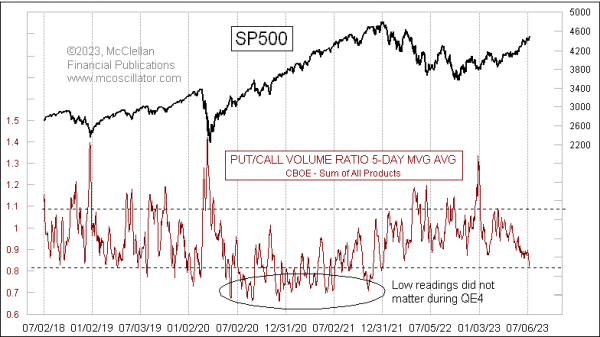Put/Call Ratio Lowest Since 2021

Free Chart In Focus email
Delivered to you every week
Persistently low readings lately for the CBOE Put/Call Volume Ratio (for all products) have pulled down the 5-day moving average to its lowest reading since the top of the last bull market in December 2021. Such readings are pretty reliably associated with meaningful tops for stock prices. That is, unless the Fed has its thumb on the scale.
Right after the federal and state governments in the U.S. shut down everything due to Covid in 2020, the Federal Reserve responded by initiating its fourth round of quantitative easing (QE4), which lasted from March 2020 all the way to the end of 2021. At its height, QE4 saw the Fed pumping as much as $1 trillion per month into the banking system. That had the predictable effect of pushing up stock prices. The actual economy could not digest being fed QE with a firehose, and so all of that money went looking for a mission. During that Fed-fueled uptrend, we saw a lot of much lower readings for the 5-day MA of the Put/Call Ratio shown in this week's chart, and they did not matter. That is a testament to the power of the Fed.
Now we have a really low reading, but no QE. In fact, the Fed is still trying to dismantle the stimulus it did with QE4 by reducing their holdings of the Treasury and mortgage debt that the Fed bought up back in 2020-21. So we do not have that same condition now to mess with what should be a perfectly good indication of trader overconfidence.
The Put/Call Ratio was first discovered by the late Martin Zweig. In his book, "Winning On Wall Street", Zweig described seeing the data published each day in the Wall Street Journal for the numbers of puts and calls traded, and he wondered if it meant anything. After gathering the data, he quickly realized the value of these data as a sentiment indication. When traders are optimistic, they favor trading call options, which (hopefully) increase in value as stock prices go up. When they are pessimistic, they trade more put options, betting on lower prices. That is the magic of examining these data. It is not a sentiment survey, where people say what they think; it is a measure of how people are actually making bets with their actual money.
Middling values really do not tell us much. It is only when the Put/Call Ratio gets to an extreme that it becomes really useful. But what constitutes an "extreme"? For that we have to put the data on a chart, and see what types of values have mattered in the past. The upper and lower threshold lines in the chart above are arbitrarily drawn, and one could reasonably argue that either of them ought to be moved up or down a little bit. It is also worth noting that the reaching of an extreme level for this (or any) indicator is not a "signal", but rather it represents a "condition". The market does not necessarily have to react immediately just because you or I may notice an extended condition.
But readings like we are seeing this week in the Put/Call Ratio's 5-day MA do tend to matter, eventually, as long as the Fed does not get in the way.
Tom McClellan
Editor, The McClellan Market Report
Jul 07, 2023
SP500’s A-D Line at New High |
Apr 01, 2022
Put/Call Ratio Range Shift |
Aug 15, 2019
Equity Put/Call Volume Ratio’s 21-Day MA |